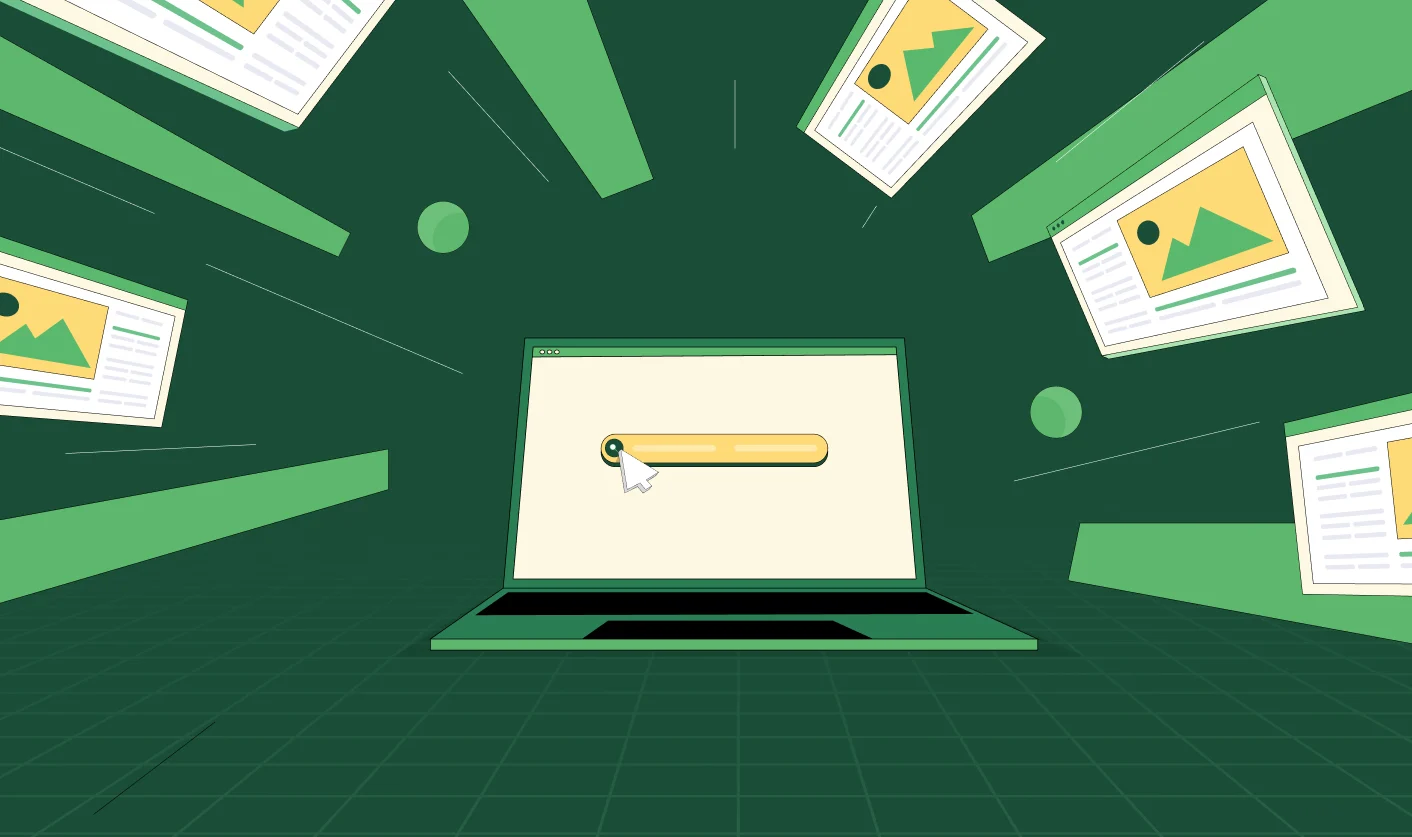If you’re sitting at a 2% conversion rate, you might feel good. After all, you just doubled from 1%. But here’s the reality check: 2% is still below average.
According to recent benchmarks:
- 25% of advertisers struggle with conversion rates under 1%.
- The median conversion rate sits at 2.35%.
- The top 25% push past 5.31%.
- And the top 10% hit 11.45% or higher.
That means if you’re cruising at 5%, you’re ahead of most SaaS competitors. But you still have massive room to grow. The top performers are aiming for 10%, 20%, or even higher.
And the lever that gets you there? Landing page optimization.
At ThunderClap, we’ve worked on 129+ B2B websites like Amazon, Razorpay, and Storylane to optimize their websites and boost conversions. In this guide, we’ll show you how to systematically optimize your landing pages with proven frameworks, case studies from companies like Notion, ClickUp, and Storylane, and a look at how AI is reshaping CRO.
If you’re ready to move out of the average bucket and into the top tier of performers, keep reading.
TL;DR
Landing page optimization can lower your CAC, boost conversions, and directly impact ROI. Here’s how we do it at ThunderClap:
- Pick one goal per landing page (free trial, demo booking, etc.).
- Write a headline focused on outcomes, not features.
- Put social proof above the fold (logos, reviews, badges).
- Simplify to one CTA (don’t overwhelm your visitors).
- Personalize with AI or user data (distinguish first-time vs. returning visitors).
- Test headlines and CTAs with a structured roadmap.
- Link optimizations to ROI metrics like CAC, LTV, and payback period.
- Build a testing roadmap. Start with messaging, CTAs, and high-leverage elements.
- Use the right tools: Unbounce, Instapage, VWO, and Optimizely to design, test, and personalize landing pages.
- Explore AI for CRO: Tools like Mutiny, Clearbit, and Drift enable dynamic personalization, predictive testing, and conversational landing pages for faster, smarter optimizations.
- And we’re learning from SaaS leaders like Notion, ClickUp, and Storylane.
Why Landing Page Optimization Matters for ROI
How much are you spending every month to drive traffic to your site? Google Ads. LinkedIn campaigns. SEO content. Now, how many of those hard-won clicks are dropping off because your landing page isn’t doing its job?
Landing page optimization is the rare growth lever that drives efficiency, cash flow, and growth velocity at the same time.
We saw this firsthand when we worked with Storylane on their website revamp.
- Total conversions up 22%
- Conversions per user up 19%
Here’s the before-and-after look.
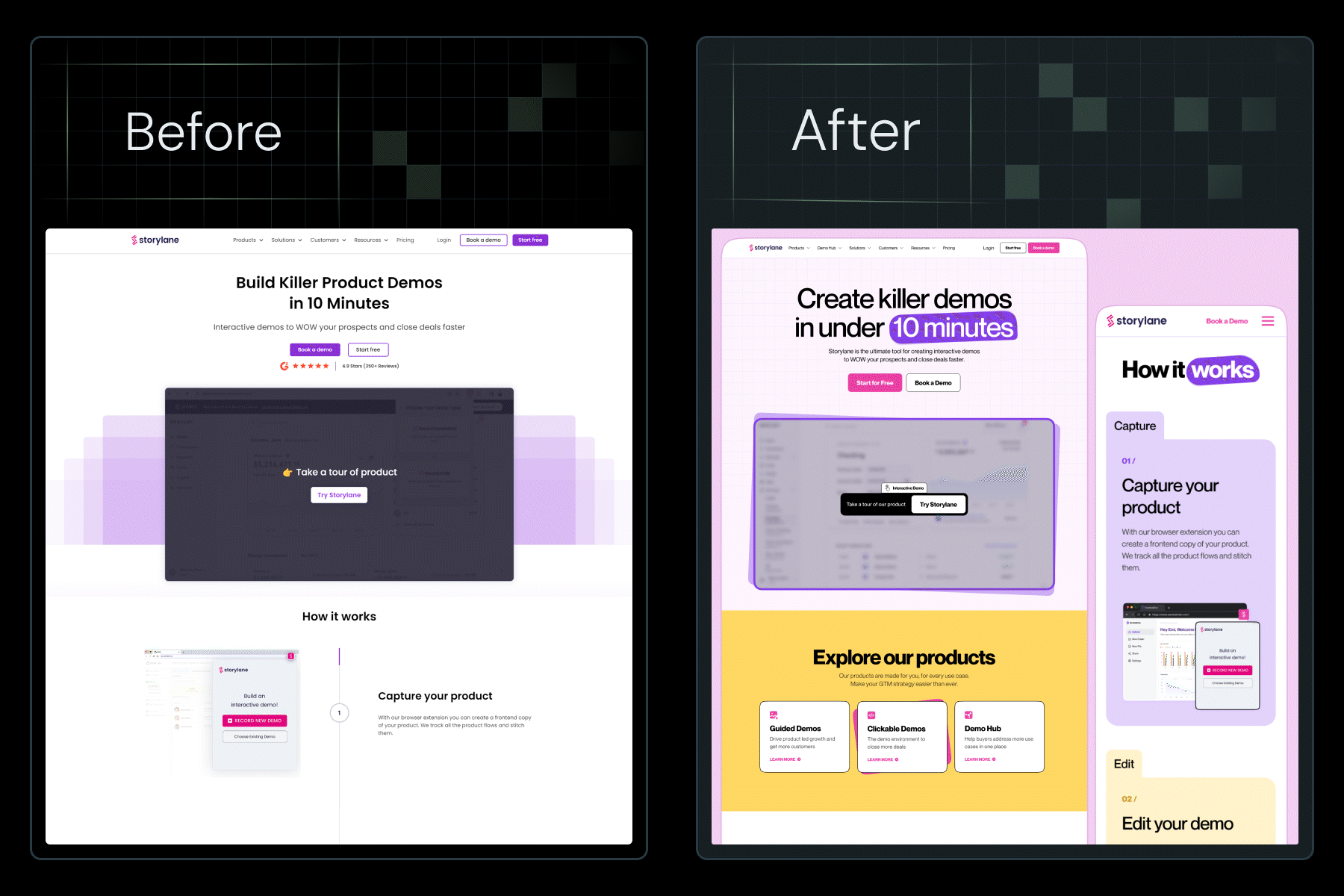
Here’s how landing page optimization ties directly to SaaS growth metrics:
1. You can cut your CAC without spending more
CAC (Customer Acquisition Cost) = Marketing Spend ÷ New Customers.
If you spend $100,000 on paid ads and convert at 3%, you acquire 300 customers → CAC = $333. Improve conversion to 6%, and suddenly you acquire 600 customers → CAC = $166.
You didn’t increase spend (you just halved CAC).
2. You speed up payback and free up cash
SaaS companies live or die by how fast they recoup CAC. SaaS companies live or die based on how fast they recoup their CAC. A faster payback means more cash to reinvest in growth. With a reduced CAC, the payback period shortens, allowing you to reinvest that cash in growth without raising funding.
3. You build more pipeline from the same traffic conversions
Every % increase in conversion compounds across the funnel. An extra 2% lift on a landing page driving 50,000 monthly visits = 1,000 more trial sign-ups → even if only 20% convert to paid, that’s 200 new customers/month.
Over a year, that’s 2,400 extra customers without buying more traffic.
Cool, the math checks out. But the real question is: what can you actually do about it?
Landing page optimization for SaaS can feel like whack-a-mole if you chase small tweaks. You can stay really busy running micro-tests (tweaking button colors, swapping stock photos, or shuffling page sections), but busy doesn’t always mean better.
The real growth comes from big, high-leverage optimizations. Let’s dive into the step-by-step playbook that actually moves your numbers for our 78+ clients across various domains, including B2B SaaS, VC funds, FinTech, and AI.
Step 1: Define the single job the page must do
Before you tweak a headline or test a button color, you need clarity: What is the primary purpose of this page?
Here’s a quick gut-check: if I landed on your page right now, would I immediately know the one action you want me to take?
Too many SaaS landing pages try to do everything on one page: get trial sign-ups, capture newsletter emails, book demos, AND push a webinar. The result is confusion and diluted conversions.
One of the things we do at ThunderClap is help clients like roommaster and Z47 set one specific goal for each landing page. Here’s how we think about it:
Framework #1: SaaS Landing Page Goal Matrix
Case in point is Notion, a SaaS brand often studied in B2B web design best practices.
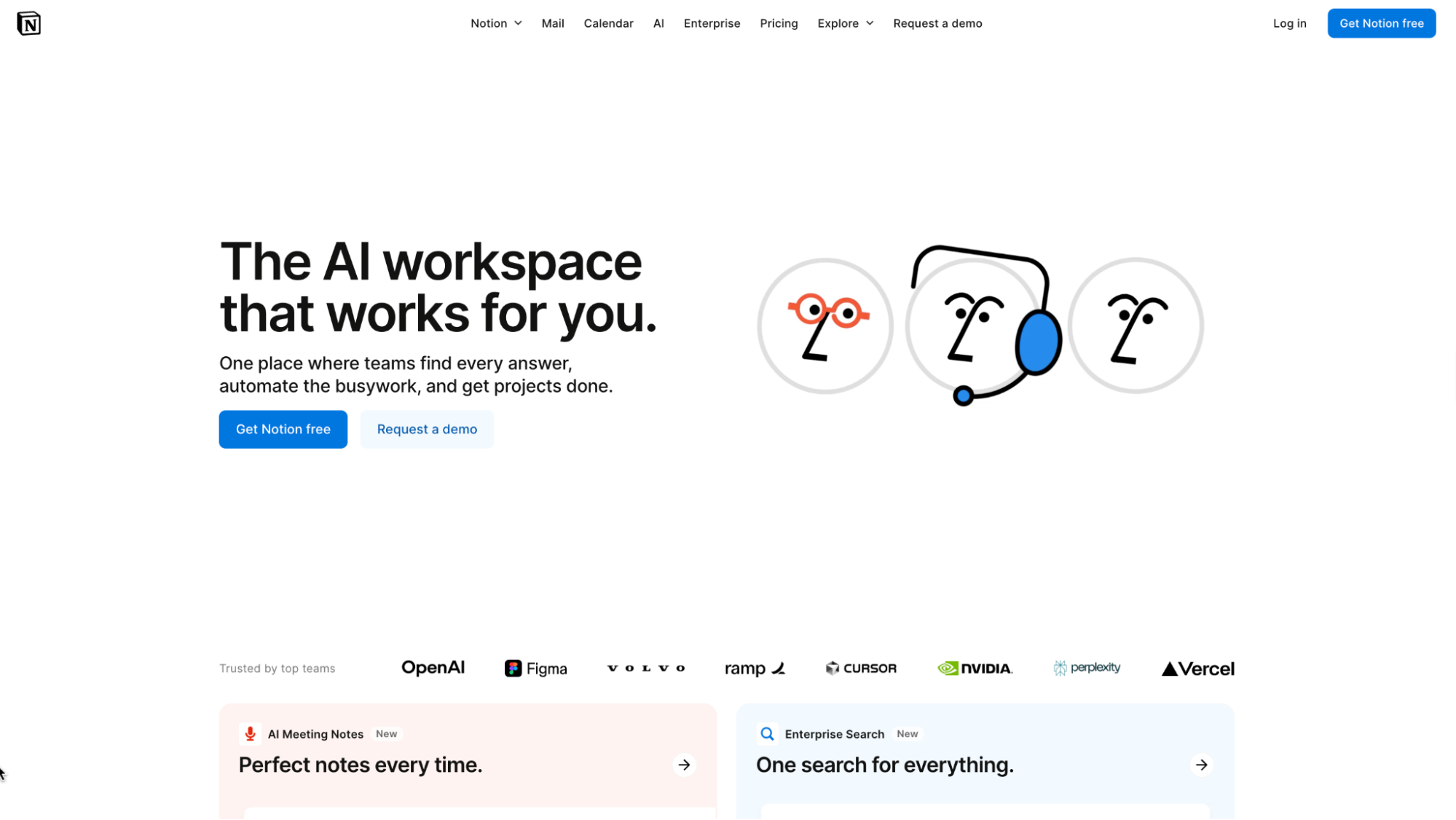
Notion’s earlier site offered multiple navigation paths and CTAs that could pull visitors in different directions. Their current homepage emphasizes one bold primary CTA: Get Notion free. In a PLG (product-led growth) model, one clear CTA reduces friction and drives people directly into the product experience.
Step 2: Create a Headline That Speaks to Outcomes, Not Features
When you land on a SaaS page that says “The #1 project management tool”, do you feel compelled to sign up? Probably not.
Your headline is the make-or-break moment. Visitors decide in 3–5 seconds if they’ll stick around. Don’t waste it describing what your product is. Use it to show what your product does for them.
Here’s how to rewrite your feature-first headline (descriptive) to an outcome-first headline (persuasive).
Framework #2: Headline Value Formula
How to write high-ROI headlines:
- Step 1: Identify your product’s biggest outcome (e.g., reduce churn, accelerate pipeline).
- Step 2: Add a timeframe or proof point (or both).
- Step 3: Add audience context.
As Ayush Barnwal, Founder at ThunderClap, lays out in our 8-step copywriting framework for high-converting landing pages, a great copy is a checklist, not inspiration.
Once your headline and copy hook them, you need to prove you’re legit. That’s where social proof comes in.
{{specficBlog}}
Step 3: Social proof to meet trust where people look
Your visitors don’t believe you. They believe your customers.
If your landing page doesn’t show logos, testimonials, or reviews above the fold, you’re forcing people to take a leap of faith. And most won’t.
Our social proof pyramid shows how we prioritize what to show:
Framework #3: Social Proof Pyramid
ClickUp Brain's landing page nails this landing page optimization strategy.
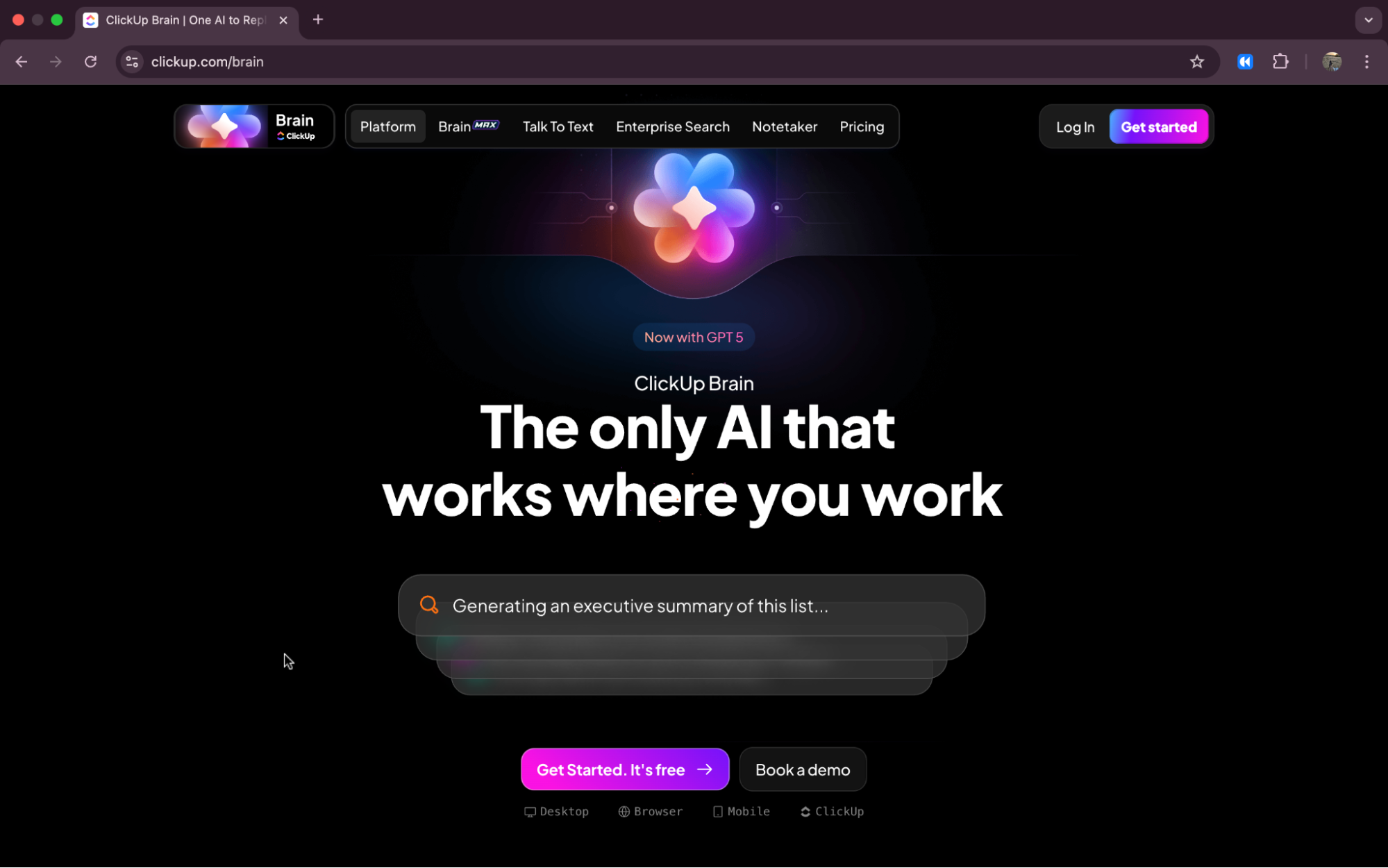
Here’s what they’re doing right to optimize landing pages for conversions:
- Bold differentiator (The only AI that works with your work).
- Clear guarantee (Save 1 day per week, guaranteed).
- Stacked logos (IBM, Booking.com, Logitech) + 150,000+ companies.
- Quantified ROI stats: 88% cost savings, 1.1 days saved/week, 3x faster tasks.
- Relatable proof (named Deadline Guardian and Content Reviewer).
- Enterprise trust badges (GDPR, HIPAA, ISO, SOC 2).
- Dual CTAs (Get Started Free + Book a Demo) for both self-serve and enterprise buyers.
Step 4: One CTA, then be obsessive about placement
One of the most common mistakes we see clients make? Too many CTAs. Visitors get paralyzed when asked to choose. But landing pages with a single CTA convert at 13.5%, while those with 2–4 CTAs convert at only 11.9% We learned this pattern from multiple website revamps, too.
Here’s the CTA hierarchy we use for our clients at ThunderClap:
Framework #4: CTA Hierarchy
If you run demos, use ThunderClap’s High-Converting Demo Page Playbook. We studied 30 B2B SaaS brands to find landing page optimization strategies that leading brands are using on demo pages (value ladder, what reps need, checklist for book demo pages).
Inside the 39-page ebook, you'll find landing page optimization best practices, an editable wireframe you can use to create a high-converting demo page for your SaaS brand, and 3 ready-to-use prompts to craft a perfect headline for your demo landing page
Step 5: Personalize with simple firmographics, then scale with AI
Say you’re evaluating a SaaS tool. You visit the landing page twice. The first time, you’re just browsing. Second time, you’re ready to book a demo. But the page looks exactly the same.
Frustrating, right?
No wonder personalized landing pages convert 202% better than generic ones.
Framework #5: SaaS Landing Page Personalization Tiers
Step 6: Build a testing roadmap
Testing is where hypotheses become growth.
Most SaaS teams fall into one of two traps:
- They don’t test at all (they launch a page and leave it untouched for months).
- Or they test the wrong things (button color, microcopy) instead of high-impact elements like messaging and CTAs.
The way out is building a testing roadmap. And when Saas teams commit, they have recorded up to 75% higher conversions through CRO.
At ThunderClap, we keep a ranked backlog and run one major hypothesis per sprint for our clients. We document winners and why they won. This is how knowledge compounds across projects (we’ve used the same lessons across dozens of clients).
You too can implement our testing pyramid. Start at the top of the pyramid (messaging and CTAs). Once you nail those, move down to design details and layout.
One of our recent revamp projects for Z47, one of India’s leading VC funds, shows exactly how applying this blueprint to messaging, structure, and supporting assets can transform both the experience and the results.
Here’s a step-by-step of what we did for Z47:
- Ran a comprehensive website + analytics audit to identify drop-offs, weak engagement, and missed trust signals.
- Conducted a competitor scan to benchmark positioning and site structure.
- Recrafted messaging around “founders first” to build trust.
- Designed wireframes with a single purpose per page to eliminate clutter.
- Built stylescapes and mood boards to align visuals with Z47’s brand book.
- Revamped the site design to be more colorful, elegant, and trust-led (team, portfolio companies, IPs).
- Launched Zero to Infinity content IP hub that positioned Z47 as a thought leader and scaled their content engine.
Here’s how the Z47 homepage evolved before the revamp vs. after applying the blueprint
In just six weeks post-revamp, Z47 saw:
- +59% website traffic
- +54% active users
- +50% engagement
- +121% direct traffic
- +465% social traffic
Also Read: 20 Proven SaaS Conversion Optimization Hacks to Boost Your Sales
Step 7: Link everything back to $$ (CAC, LTV, payback)
Your CEO doesn’t care that your headline test boosted conversions by 4%. They care that it lowered CAC or added $1M in pipeline. If you can’t tie landing page optimization back to money, you’ll never get budget or buy-in.
Here’s a quick helper on reframing CRO metrics into business language:
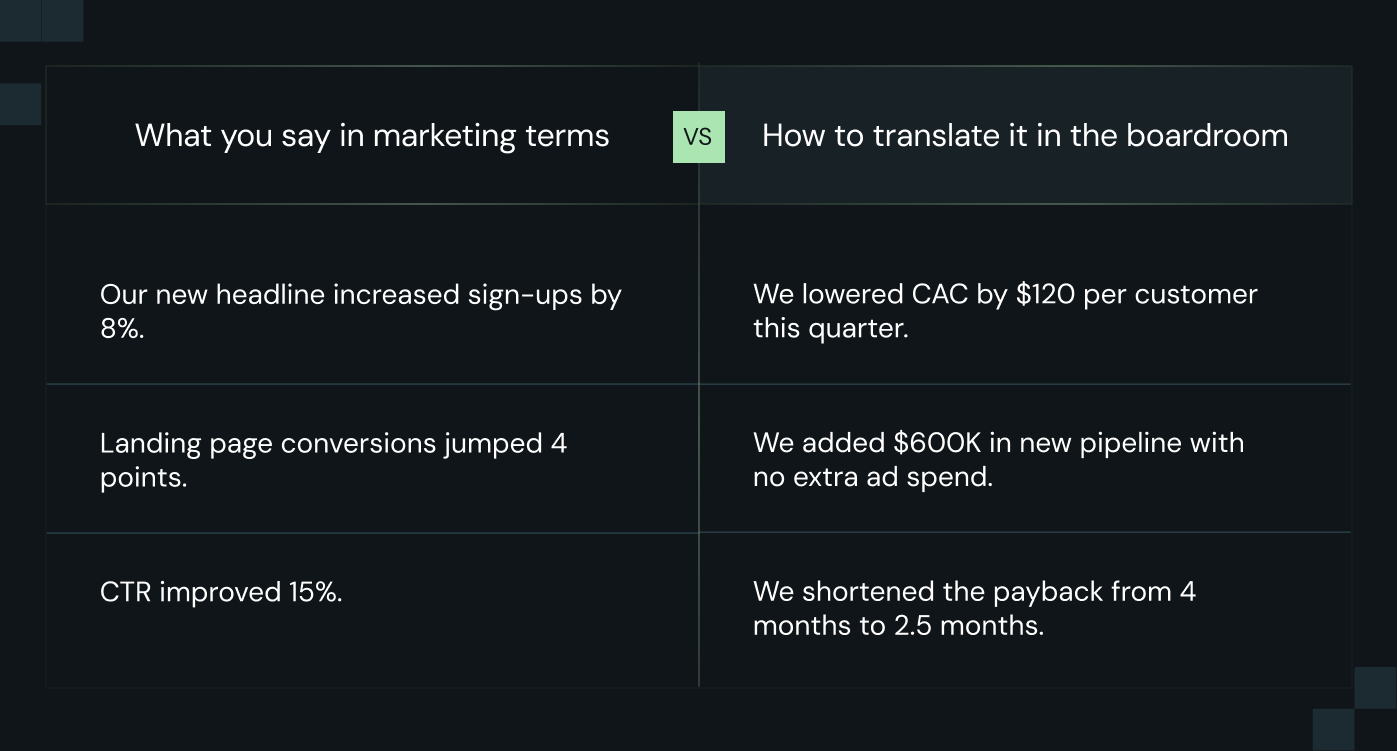
Talking the talk is important, but you also need to show where the money shows up in the numbers. Here’s the four-metric framework every marketing lead lives by.
Framework #7: ROI Impact Model
Also Read: 5 Tips & Best Practices for Maintaining your WebFlow Website
6 common mistakes in landing page optimization (and how to fix them fast)
Before you optimize, it’s worth calling out the pitfalls most SaaS teams fall into. Kiran audited over 100 SaaS home pages, and the same landing page optimization mistakes keep reappearing.
Chances are, you’ve made one (or more) of these mistakes. Let’s break them down.
1. Treating all traffic the same
Not all visitors arrive with the same intent. Someone clicking from a LinkedIn ad isn’t in the same headspace as someone arriving from a branded Google search. Serving them the same generic landing page is a wasted opportunity.
2. Designing for aesthetics, not action
It’s tempting to obsess over “pretty” designs with complex animations or heavy imagery. But what looks slick to you may distract or slow down the user.
3. Ignoring mobile experience
Too many SaaS landing pages are designed desktop-first and shrink badly on mobile. Long forms, tiny CTAs, or broken layouts drive bounce rates through the roof.
4. Skipping message-match with ads
Ever click an ad promising one thing, only to land on a page that talks about something else? That disconnect kills trust instantly.
5. Relying too heavily on templates
Using pre-built landing page templates is fine for speed, but if you never customize beyond swapping in your logo and headline, your page will blend in with every other landing page out there.
6. Failing to refresh proof and content
Outdated proof hurts credibility. Logos from 2019, old review badges, outdated product screenshots, these small signals scream stale to visitors.
5 landing page optimization tools for SaaS teams
If you’ve ever searched for “best landing page optimization tools,” you know there are dozens of platforms promising to boost conversions, run experiments, and personalize your pages.
But you don’t need every tool under the sun. What you need is a lean, reliable toolkit that helps you design, test, and scale landing page optimization.
Think of this list as your starting stack:
- Unbounce → Great for building and A/B testing landing pages without dev help. Drag-and-drop + dynamic text replacement for personalization.
- Instapage → Advanced features like heatmaps, multivariate testing, and ad-to-page personalization.
- VWO → Best for structured CRO programs. Offers testing, heatmaps, session recording, and ROI reporting.
- Optimizely → Enterprise-level experimentation platform. Ideal for SaaS teams with high traffic.
- Google Optimize (sunset in 2023, but replaced by GA4 experiments) → Still worth mentioning as part of GA4’s experimentation suite.
Pro Tip: Pick one tool for building (Unbounce/Instapage) and one for testing (VWO/Optimizely). This gives you both speed and structure.
The future: what AI will change in CRO
AI is quietly reshaping how SaaS teams build and optimize landing pages for conversions. What used to take weeks of manual work (brainstorming copy, setting up tests, waiting for significance) is starting to happen in hours.
Recent studies show that AI integration can lift conversion rates by as much as 30%. HubSpot, for example, saw a 10–15% conversion increase after implementing AI-driven personalization across landing pages.
So if you’re not thinking about how AI fits into your CRO process, you’ll soon be outpaced by competitors who are.
Here’s what’s already changing (and where we’re heading in the next 2–3 years):
1. AI-driven personalization at scale
Tools like Mutiny and Clearbit already let you swap copy based on firmographic data (industry, company size, even tech stack). The next wave goes further: AI will automatically adjust headlines, CTAs, visuals, and even pricing emphasis in real time based on who’s visiting and what stage they’re in.
2. AI-powered copy + design testing
If you’ve ever spent a week writing five headline variations, only to watch them flop, this one will hit home. AI can now generate dozens of on-brand headlines, CTAs, and layout variations in minutes.
Instead of creative bottlenecks, you’ll be able to test 50 angles at once (with AI not only writing the copy but also predicting which ones have the highest chance of winning before they even go live). That means faster cycles, less guesswork, and a pipeline of fresh experiments ready every sprint.
3. Predictive CRO
Today, you might run an A/B test for weeks waiting for statistical significance. By then, you’ve burned your budget and lost time. Using behavioral data (scroll depth, time on page, click patterns), AI can predict winners in days, not weeks. That means you can kill underperforming variations quickly and double down on winners faster.
4. Voice & conversational landing pages
Static forms are one of the biggest drop-off points in SaaS funnels. Nobody likes filling out 12 fields just to see a demo. AI-powered chat (like Drift) is already replacing forms with conversational flows that feel natural.
The future is landing pages where visitors talk (by text or voice) and the page adapts in real time.
What does this mean for you?
The rise of AI doesn’t mean you stop optimizing (it means your role evolves). Marketing teams that embrace AI will out-test, out-learn, and out-convert their competitors. The question is whether you’ll be leading that curve… or trying to catch up.
Want to put this into practice without boiling the ocean? Here’s a quick starter stack of AI-powered CRO tools you can try today:
Your AI CRO Starter Stack
Pro tip: You don’t need to adopt everything at once. Start with one personalization tool (like Mutiny) and one AI copy/testing tool (like Jasper). That’s enough to give you quick wins without overwhelming your stack.
Your landing page optimization journey: do it yourself or let ThunderClap take you further
You now have a battle-tested step-by-step guide on how to optimize your landing pages. If you’ve got the time and resources, you can absolutely start on your own.

Even these small changes can deliver quick wins.
But most teams we work with hit a ceiling. DIY gets you part of the way there. Then the tests stall, the design gaps show, and the results plateau. Scaling CRO into a reliable growth engine takes structured playbooks, design + dev muscle, and experience knowing what works across industries.
At ThunderClap, we’ve optimized 129+ B2B websites, partnering with mid-market SaaS brands and enterprises like Amazon, Razorpay, and Storylane. Their challenges are always familiar: unclear positioning, low conversions, and a site that doesn’t match the maturity of the company.
{{ctaBlock}}
What we bring to the table is a proven expertise in having it done across industries, helping clients double demo signups, cut CAC, and reposition themselves as category leaders.
If you’re ready to make your landing page your #1 salesperson, we’d love to show you how. Let’s audit your current funnel, pinpoint where the leaks are, and build a roadmap that gets measurable results in weeks, not months. Book a 30-minute demo!
FAQs
1. What are the best landing page optimization strategies for SaaS?
The best landing page optimization strategies include setting one clear conversion goal, writing outcome-focused headlines, showcasing social proof above the fold, simplifying CTAs, and running structured A/B tests. SaaS leaders like Notion and HubSpot use these approaches to improve conversions.
2. How do I optimize landing pages for conversions?
To optimize landing pages for conversions, focus on clarity and trust. Reduce CTA overload, personalize experiences for different segments (SMB vs. enterprise), and test messaging elements like headlines. Adding trust signals like customer reviews and G2 badges can significantly lift conversions.
3. What are SaaS landing page optimization best practices?
Best practices for landing page optimization for SaaS include:
- Clear single CTA
- Outcome-driven headline
- Social proof above the fold
- Personalized content by audience/region
- Continuous A/B testing with a roadmap
These practices ensure SaaS landing pages maximize ROI.
4. How do I measure ROI from landing page optimization?
Link landing page performance to financial metrics: CAC (Customer Acquisition Cost), LTV (Lifetime Value), and payback period. For example, if your conversion rate doubles from 3% to 6%, your CAC is cut in half (directly boosting ROI).
5. What tools help with landing page optimization for SaaS?
Popular landing page optimization tools for SaaS include Unbounce, Instapage, VWO, Optimizely, and HubSpot CMS. These platforms help run experiments, track conversions, and personalize landing pages for maximum ROI.


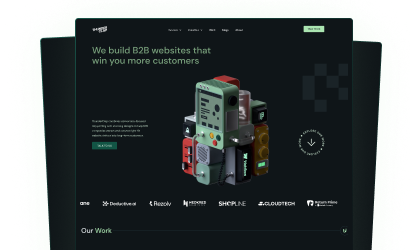




Interested in seeing what we can do for your website?








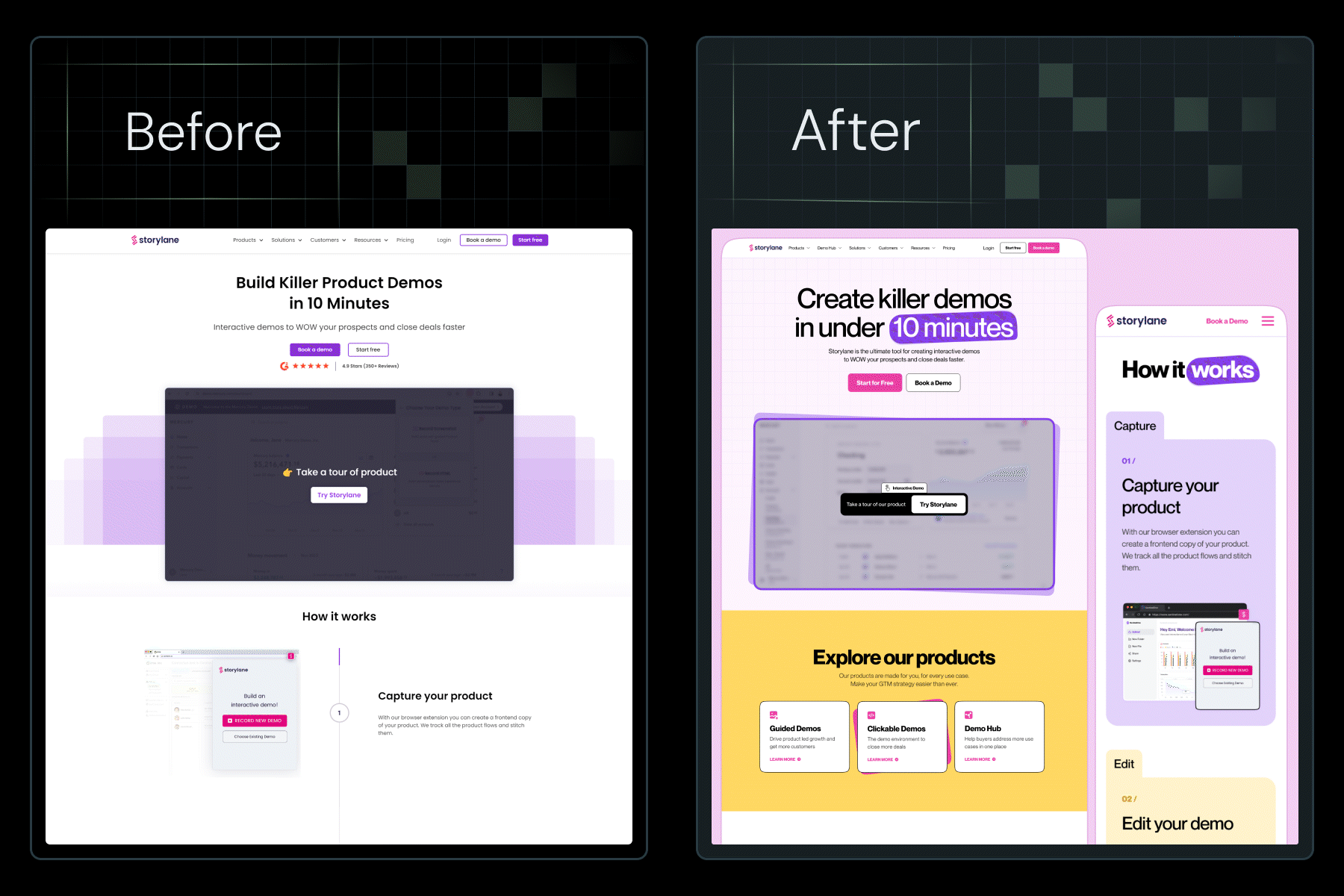






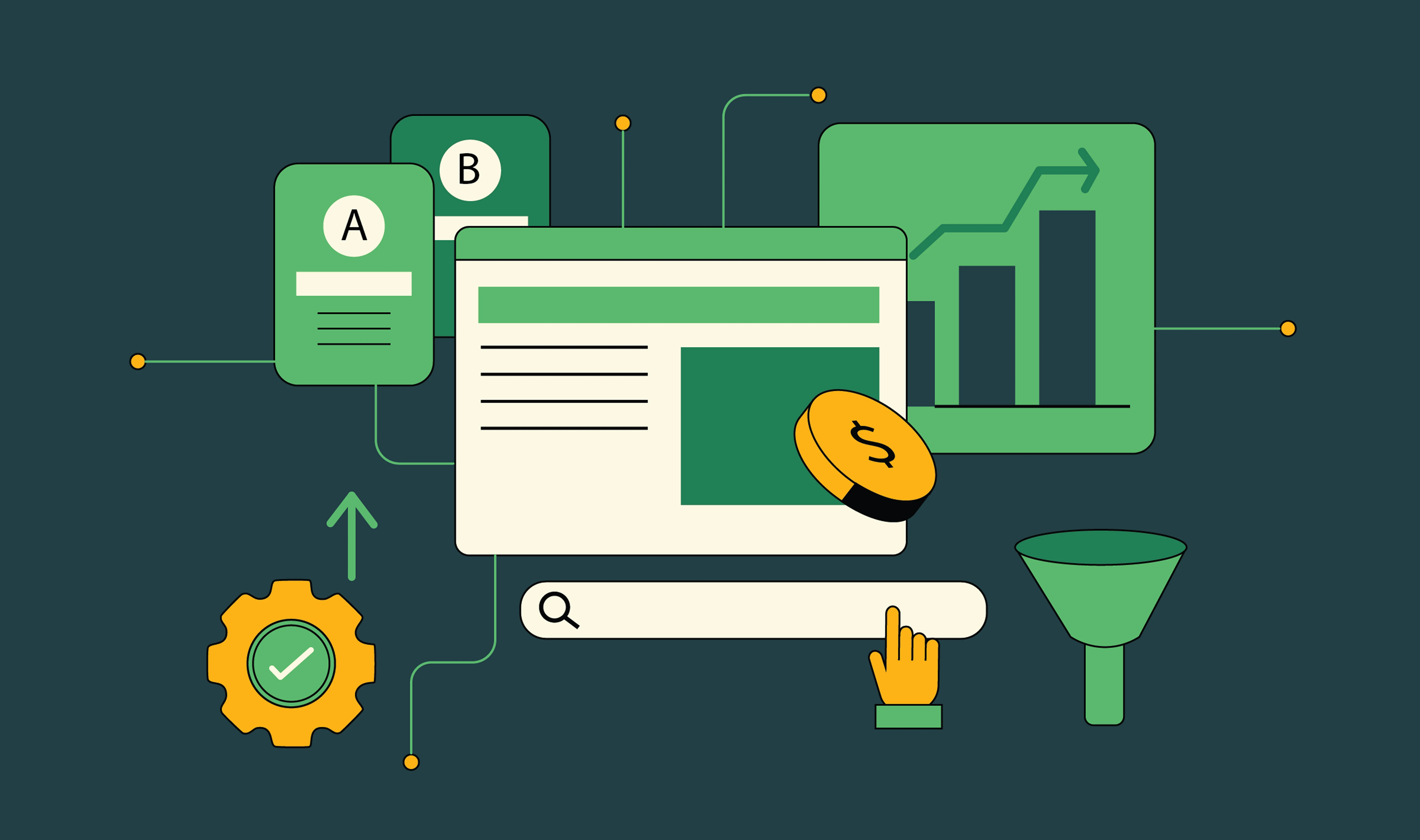
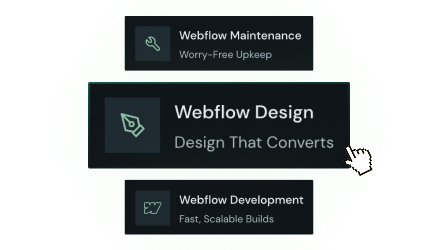
.png)
